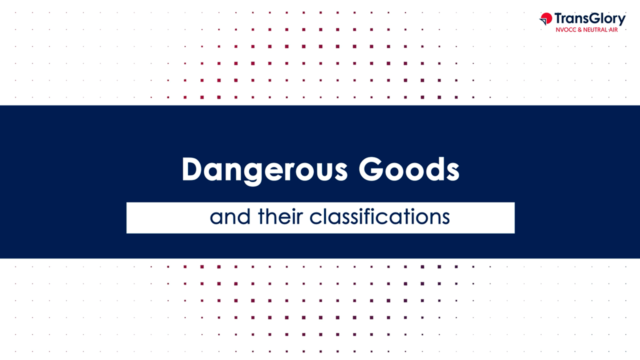When transporting a client’s cargo it’s always important to conisder and be aware of what we are working with. Different goods entail different ways of handling, storing and shipping them as well as resulting in different documents to enter them into a country, like export and import licenses.
One particular kind of cargo you should know extremely well is the one know as dangerous.
What is considered Dangerous Cargo?
Dangerous Goods (also known as Hazardous Cargo or Hazmat), are substances or materials that when transported, handled or stored pose a risk to health, safety, property or the environment.
Given their dangerous nature, appropriate management and handling of the different hazardous goods is vital: from choosing the correct and specific storage solution to the best shipping partner for your cargo. That’s why dangerous goods are divided into 9 classes. Depending on which class your cargo falls into it will affect how you pack, label, store and transport the cargo.
Watch our first video for this Dangerous Cargo series
Hazardous Cargo Classifications
To be considered a dangerous good, an item should fall into at least one of the nine dangerous goods classifications.
- Class 1: Explosives.
- Are considered explosives those products possessing the ability to alight or detonate during a sudden and violent chemical reaction (usually passing from a solid state to a very hot gas). There are 6 sub-divisions depending on the products behaviour:
- 1.1 Mass explosion hazard, 1.2 Projection hazard only, 1.3 Fire hazard and minor blast or projection hazard, 1.4 Minimal hazard, 1.5 Blasting agents, 1.6 Very insensitive detonating articles.
- Are considered explosives those products possessing the ability to alight or detonate during a sudden and violent chemical reaction (usually passing from a solid state to a very hot gas). There are 6 sub-divisions depending on the products behaviour:
- Class 2: Gases
- This classification includes compressed gases, gases in their liquefied form, refrigerated gases, mixtures of gases with other vapours and products charged with gases or aerosols. These type of gases are hazardous because they can chemically react with oxygen and often can be flammable, toxic or corrosive. That’s why this class has three sub-divisions:
- 2.1 flammable gases, 2.2 non-flammable gases and 2.3 toxic gases.
- This classification includes compressed gases, gases in their liquefied form, refrigerated gases, mixtures of gases with other vapours and products charged with gases or aerosols. These type of gases are hazardous because they can chemically react with oxygen and often can be flammable, toxic or corrosive. That’s why this class has three sub-divisions:
- Class 3: Flammable liquids.
- This class contains any liquid, a mixture of liquids, or liquids containing solids that ignite at a much lower temperature than others, turning them into high risk cargo as they are very volatile and combustible and can ignite during transportation.
- When packing them, flammable liquids are divided into two categories according their boiling point (above or below 35º C) and flashpoint (below 23º C).
- Class 4: Flammable solids.
- Products considered flammable solids are classified as products that are easily combustible and can ignite during transportation. There are 3 sub-divisions for Class 4 dangerous goods:
- 4.1 Flammable solids (items that burn more easily than normal combustible materials), 4.2 Spontaneous combustion (solids or liquids that spontaneously ignite when in contact with oxygen), 4.3 Dangerous when wet (substances that emit flammable gases when in contact with water).
- Products considered flammable solids are classified as products that are easily combustible and can ignite during transportation. There are 3 sub-divisions for Class 4 dangerous goods:
- Class 5: Oxidizing substances and organic peroxides.
- Cargo that falls in this category are products that can react violently because of their high oxygen content. They react readily with other flammable or combustible materials, which can cause fires even in confined spaces. Fires created by these substances are also incredibly difficult to extinguish, which makes them even more dangerous.
- Oxidizing products (oxidizers) are categorized as 5.1 and aren’t necessarily combustible on their own, but the oxygen they produce can cause combustion with other materials. Organic peroxides are categorized as 5.2 and they have a molecular structure that makes them extremely unstable and liable to ignition, they can even combust individually, as they are designed to be reactive for industrial purposes.
- Cargo that falls in this category are products that can react violently because of their high oxygen content. They react readily with other flammable or combustible materials, which can cause fires even in confined spaces. Fires created by these substances are also incredibly difficult to extinguish, which makes them even more dangerous.
- Class 6: Toxic and infectious substances.
- Toxics are classified as 6.1 and include substances that cause serious injury or harm to human health, even death, because because of their toxicity.
- Infectious substances are classified as 6.2 and refer to goods that contain micro-organisms (pathogens) that cause infectious diseases in humans or animals.
- Toxic gases are, as seen above, classified as 2.3.
- Class 7: Radioactive material.
- Radioactive materials are items containing unstable atoms that change their structure spontaneously in a random fashion. These changes are what makes the material emit invisible radiation that may cause chemical or biological change-ionising radiation, which is generally dangerous to the human body, depending on the type of radiation, the dose and the duration of the exposure.
- Class 8: Corrosive substances.
- Corrosives are highly reactive materials that when encountering other materials cause chemical degrading on them. If these materials are living tissue, corrosives can cause severe injury.
- Class 9: Miscellaneous dangerous substances.
- As the name suggests, this category covers substances that present a danger not covered in the other classes.
Examples of day to day dangerous materials
A lot of our day to day items that fall into at least one of the dangerous cargo classification, starting with your own mobile phone or laptop.
- Most commonly used items fall into the flammable category:
- Fuels in internal combustion engines for motor vehicles and aircrafts are of course considered flammable liquids, which means this category makes up the largest tonnage of dangerous goods moved by surface transport.
- Deodorants, kitchen cleaners and lighters are considered flammable gases. Perfumes, paints, dyes, nail polishes and adhesives fall into flammable liquids. Matches are a good example of flammable solids.
- Other common hazardous items are:
- Fireworks, of course, which fall into the explosives categories.
- Fertilizers, considered oxidizing, and pesticides, toxic, are also classified as hazardous materials. Some clinical waste can also be considered toxic, as it may contain biological waste as pathogens or viruses.
- Some medical equipment and waste can be considered radioactive, as it can have traces of different kind of radioactive substances.
- Bleaches and drain cleaners, along with vehicle batteries are corrosive.
- Lithium batteries like the ones on laptops and mobile phones and magnetized materials fall into the miscellaneous category.
Are dangerous goods the same as prohibited goods?
Although some dangerous goods can be classified also as prohibited goods in a specific country, it’s important to not confuse, as a whole, the two. Prohibited or restricted goods are those that will be seized at customs because they’re banned to enter that country for reasons linked to health, environment, security and legislation. And the person transporting them can even be liable to a penalty.













